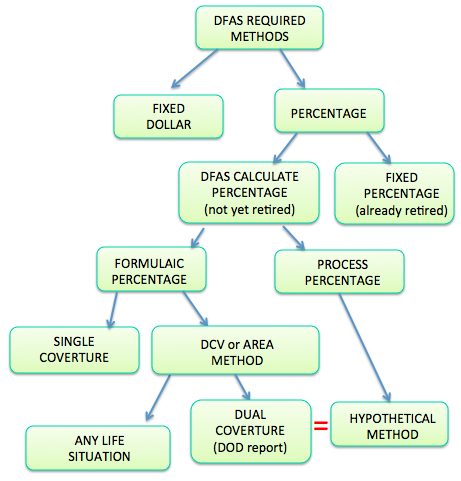Division of
Military Retirement Pay - Area Method
© 2018
Brian Mork, Ph.D. [Rev 2.1]
Home •
Site Index • Wiki • Blog 

Update: The 2017 National
Defense Authorization Act changed the definition of "Disposable
Retirement Pay". This mimics the calculations discussed here -
one coverture fraction for time or points, and a second coverture
fraction for rank/longevity or salary. However, as of January 2018,
phone calls with DFAS
paralegals confirm the only type of divison they accept for
post-NDAA2017 cases is the Hypothetical Method. DFAS is implementing law intent by ignoring the law's letter:
The Hypothetical Method percentage they calculate must be applied to the
old definition of DRP. Otherwise, the discount is double-applied:
once by the ratio of hypothetical salaries and once inside the
definition of DRP. When the marriage
starts after the military career,
or with multiple spouses, the Area Method is still the only way to
equitably calculate the marital asset. Additionally, the dual
covertures in the Area Method can accomodate both the intent and letter
of the new law. For more
information, see the web page tutorial on the
USFSPA amendment in the 2017 NDAA law. .
Abstract
This document presents the Area Method (AM) or Dual Coverture Value
(DCV) method of
dividing a military retirement upon divorce. Because the name DCV
confused people, the name was changed to a more descriptive "Area
Method". Original research reveals the Area Method accomplishes
the
same
division as older methods, yet is simpler. AM
also applies to a much wider scope of life situations which were
previously impossible. AM works for Active Duty or Reserve, and any
combination of marriage before or after military duty - even multiple
marriages. For a Reservist, it also properly handles Reserve early
retirement (retirement payments before age 60, earned and accrued only
after January
28, 2008). No other method
can do all of this with equity. AM can save
significant litigation costs because the simplicity and clarity invite
equitable mediation.
This page includes a lot of mathematics. Another web page gives practical information
about using AM in the legal system. Single
Coverture and Dual Coverture are discussed on other web
pages. A letter
to DFAS proposes the Area Method to replace the Hypothetical Method
because it is easier and more capable and backward compatible.
Introduction
USFSPA
laws allows military retirement benefits to be divided as a present day
asset rather
than future income. Doing so often manifests in a divorce order
that
says the spouse is awarded nominally 50% of the "military retirement
earned during the marriage." You cannot believe how unecessarily
complicated it has gotten to actually describe what portion
was earned during the marriage!
The stakes are large.
Military retirements are a significant benefit,
earned by both women
and men. As of March 2011, there were more
than twice as many military women divorcing (local
copy) than men. Among
enlisted, the military women divorce rate is
about 3x that of men. The overall military divorce rate in 2011
is
64%
higher
(local copy) than it was in 2001.
Military
divorce is a significant social issue
affecting both sexes. Dollar value of a military retirement in 2012
dollars range from $945,000 for an E-7 to
$2,800,000 for an O-8 (20 yr E-7, or 30 yr O-8, living until age
75).
AM discussed
in this document addresses how to describe what part of a military
retirement is divisible as a marital asset and calculate the coverture
fraction needed by the military Defense Finance and Accounting Service
(DFAS). Athough AM is applicable to Active
Duty and Reserve
military retirements, if you are intested in Reserve military
specific issues,
please also see another web page about dividing
military reserve retirement pay. Additional web pages deal
with law and statutes,
promotion enhancements,
dual
coverture, practicum
and examples, and a proposal
to DFAS.
Discovery
My graduate degree taught me to handle data and numbers with fidelity,
and to provide defensible answers that represent truth. My
aerospace
flight test engineering work involves using data and metrics to create
and test
models of the real world on which people's lives depend.
Mathematical tools are used to monitor, verify, and predict the real
world. I turned these skills toward division of military retirements.
I developed the Area Method (AM) model of military retirements that
allows easy math to divide
this marital asset in the case of divorce. Division methods have
accumulated since the 1982 USFSPA laws and a 1998 Department of Defense
Report to Congress regarding the functionality of USFSPA laws.
Spouses, attorneys, and judges have struggled to understand the
military retirement system and have grappled with equitable division
through
lengthy, repeated, and narrowly scoped litigation.
The new AM
model offers a better way! AM is a family of division
formulas that are plug-n-play replacements for the complicated
DFAS methods that exist for both Reserve and Active Duty
retirements. At the same time, AM can divide military retirement
assets in marriage situations
that DFAS methods simply cannot do. AM even can do multiple ex-spouses
rather than the inequitable "first come first serve" method DFAS is
currently limited to (see "Maximum Percentage" paragraph in a summer
2000 article published in General
Practice, Solo & Small Firm Division magazine.)
Over the last few years, I have had the
opportunity to consult for attorneys and clients going through divorce,
and AM has proved to be particularly useful in arbitration and
mediation because it is so lucid that it removes the desire to
litigate. I am looking for
professional review from the legal
community, and partners to publish AM in family law journals and other
newsletters reaching out to educate family law attorneys.
Comparison of Methods
When dealing with future disbursed civilian retirements, a coverture
fraction
typically calculates what portion of a retirement was earned
during the marriage and is a marital asset. The marital asset
portion is then divided like other assets. This is a core concept: although a
military retirement can be treated as a marital asset, most times only some
of the military retirement is a marital asset.
Quantitatively
describing the marital portion is the key to all division
methods. The marital portion is usually expressed as a fraction
or percentage (not
a dollar value) because the size of the retirement paycheck changes
each year based on changing military salaries:
Ex-spouse monthly payment =
Share Fraction * Marital Fraction * Changing Military Retirement
Pay
The goal is to determine the Marital or Coverture Fraction, multiply by
the Share Fraction (often 50%), then document the percentage number in
a court
order. Each month, DFAS will multiply that percentage by the
retirement pay and determine the ex-spousal payment. A hierarchical
diagram of all methods is given below. It helps to
understand that the purpose of any method is to simply generate a
marital fraction. After
all the effort is said and done, creating the percentage number is the
entire point of all the methods except the fixed dollar method.
The red equal sign in the green flowchart above is meant to indicate
that the Dual Coverture and
Hypothetical
methods yield the same percentage if one stipulates that COLA is the
same as military pay raises each year. Much more documentation is
available from the references
below.
Some authors, such as attorney Mark Sullivan in his "Silent Partner"
series, misrepresent this issue. For example, on Page 7 of
his "Military Pension Division: The Servicemember's Strategy" edition,
he states, "There are four separate ways to make the division that DFAS
will accept." This is not true.
Sullivan fixates on Fixed Dollar, Percentage Clause, Formula, and
Hypothetical because the DFAS document "Guidance on Dividing
Military Retired
Pay" (see references at the bottom of this webpage) offers these four
examples. However, examples do not delineate acceptable
division methods. In fact, there are only two acceptable division
methods for DFAS: Fixed Dollar or Calculable Percentage. Either
you give them a dollar amount, a percentage amount, or you tell them
how to calculate a percentage amount when the military member retires.
Sullivan's writing and legal document templates are
often used in court nation wide, so it's important to drive this issue
to
completion and replace Sullivan's confusion. There are TWO
acceptable ways to express a division to DFAS, and any calculation or
process or method providing one of those to ways is acceptable. If
there is any doubt, you
may reference USFSPA 10 USC 1408(a)(2)(c) directly:
"[A court order,] in the case of a
division of property, specifically provides for the payment of an
amount, expressed in dollars
or as a percentage
of disposable retired pay, from the disposable retired pay of a member
to the spouse or former spouse of that member." (underline added)
The DFAS examples of Percentage Clause, Formula, and Hypothetical
Method are simply different examples of how to calculate a
percentage. Anything that
gives DFAS a way to calculate a percentage is acceptable.
A tabular comparison of method features is
given below.
Method
of Division --->
|
Area Method
(AM)
|
Dual
Coverture (DC)
|
DFAS
Hypothetical Method (HM)
|
Civilian
Single Coverture Fraction (SC) *
|
Active Duty and Reserve?
|
Yes
|
Yes
|
Yes,
but 6 versions confuse courts
|
Yes
|
Time-value of money given after
payments start?
|
Both
receive military pay raises.
|
Both
receive military pay raises. |
Both
receive military pay raises.
|
Both
receive military pay raises. |
Time-value of money after
divorce, but before before payments start?
|
Both
receive military pay raises.
|
Both
receive military pay raises.
|
Spouses
treated differently -
military receives military pay raises; ex-spouse receives COLA
|
Both
receive military pay raises.
|
| Avoids hand-calculation of COLA
and hypothetical "High-3" basepay? |
Yes |
Yes |
No |
Yes |
| Post-marriage merit promotion
enhancements belong only to military member, per DoD report to Congress
and Appellate Courts? |
Yes
|
Yes
|
Yes
|
No
|
Able to set
aside duty value
pre-existing the marriage? (required in many states)
|
Yes
|
Yes
|
No
|
Yes
|
Able to set aside promotion
value pre-existing the marraige?
|
Yes
|
No
|
No
|
No
|
Protects ex-spouse from
pre-marital set aside at higher rank?
|
Yes
|
No
|
No
|
No
|
Handles promotions and service
credit for multiple spouses?
|
Yes
|
No
|
No
|
No
|
* Although civilian methods are inappropriate
for dividing a
military retirement, this column is included in the table because some
attorneys/courts continue to use only this method because this is what
they're familiar with.
This behavior damages military members with lack of equity, and is
inequitable in many cases as annoted above. If a myopic view continues,
courts will continue to be reversed and attorneys risk malpractice
settlements. Web page titled "Division
of Military Retirement Pay - Promotion Enhancement" gives a point
by point rebuttal to the civilian
method; continuing to use it when it's documented to be
inferior and inequitable is inexplicable.
Only the Area Method allows proper
handling of military duty and promotions that existed as a pre-marriage
asset. Like a car or dining room table
pre-existing the marriage, pre-existing assets are not divisible.
Pre-existing retirement asset value
can be quantitatively separated and does not comingle with the rest of
the retirement. Only AM can do this.
Additionally, when more than one spouse is involved, only the AM can
properly divide a military asset among multiple spouses and the
military member.
Area Method
The value of both Reserve and Active Duty retirements can be
visualized as an area. The idea of an area (multipling two
numbers toegher) works because a product of two variables is how a
military monthly retirement check is calculated, plus an extra 2.5%
factor and any conversion factor between points, months, years and
days.
Monthly retirement = (2.5% base pay) *
(service credit in years)
For example, an Active Duty person retiring after 20 years would get
50% of their monthly base pay. For a Reservist, service credit
has been expressed in points to
divide retirements. The Area Method could do fractions that
way, but instead points are
converted to months to maintain similarity with Active Duty
retirements,
and to match the Federally
mandated retirement formula,
which converts all points to years. For a Reservist, the Federal
goverment defines years = points/360, so months = points/30.
In the
diagram below the
horizontal axes shows the number of months of military duty for
retirement.
This example happens to be from a Reservist, so the numbers were
obtained from points. The military member had 1129 duty points when
they married (1129/30=37.633 mo), 6300 points (210 mo) points when
divorced, and 7990 points (266.333 mo) as of retirement.
The vertical axis is monthly base pay looked up on a pay chart for a
single year (2009 in this example). You can use whatever year you
want, but all three values
on the vertical axes are looked up on the SAME paychart.
Do not look up the earlier
values using earlier pay charts. Use the same year paychart to find
basepay
of the different ranks and different times.
Because the
numerically precise and quantifiable nature
of a military retirement allows such calculations, there is no
comingling.
The area
of any part of the diagram
represents asset value. The white part of the diagram shows the
portion of the total retirement that is a marriage asset. The
white part is to be divided. The shaded parts are not to be
divided.
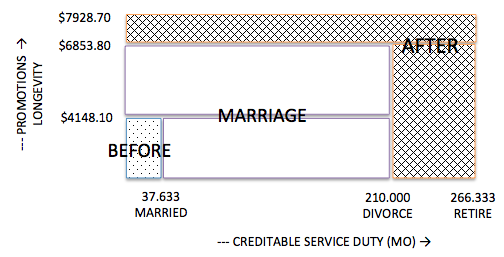
Consider the three separate, non-comingled portions that constitute the
entire retirement value. Remember, asset value is represented by
area of the
diagram:
- Before Marriage.
Dotted area. The dotted portion earned before the marriage is not a
marriage
asset. It pre-existed the marriage and because of this, it is not
a marital asset according to state law in almost every state of the
union. The area value is quantifiably separate, and is not
co-mingled like a bank account brought into marriage. When
listing assets during divorce discovery, each party
lists bank accounts and assets. During this time, it is
appropriate to note "militarly retirement asset presently worth 2.5% *
$4148.10 * (1129/360) yr = $325.22/mo"
was earned before the marriage, and is quantifiably separable, and is
not co-mingled with anything during later years, and is not a marital
asset. This is identical to listing a car or motorycle or dining
room table you owned before the marriage, and having those items exempt
from division.
- During Marriage. White
area. This area is typically the asset portion divided.
- After Marriage.
Cross-hatched area. Case law sometimes allow
civilian passively-earned enhancements after a marriage to be divided
when the receiving party has to wait to get the money. Duty
points and promotions earned after marriage
are not
passively earned like interest on a bank account or time-value of money
or dividends of a 401(k) type retirement. Dividing passively earned
enhancements may be appropriate to return time value of money --
appropriate for an investment or bank account that can not yet be
transfered. However, military duty and
promotions are actively earned
enhancements based on effort, schooling, study, and testing. They are
not passively earned like bank interest; they are earned by additional
work and
effort. Done
after marriage, this effort is not shared by an ex-spouse. This area of
enhanced retirement value earned after the marriage is not a
marital asset and should not be divided.
If you want to try numbers specific to your situation,
download the Area Method calculator
spreadsheet (pre-NDAA 2017 or post-NDAA 2017) from the references section below.
A practicum with
step-by-step examples is also available. A letter
to DFAS includes a spreadsheet
showing the Area Method or Dual Coverture Value calculations.
To divide assets, there is a certain sequence a court
must do. If any one of these steps are skipped, court orders are
susceptable to successful appeal, assuming proper documentation was
submitted during the original court action. Here
are the steps:
- Determine if something is a marital asset. USFSPA allows, but
does
not direct, a court to consider military retirement as a marital asset.
However, all portions of a military retirement
are not marital assets unless all
of the military career was during the marriage.
- Determine asset values as of some date. This is typically
the date of separation, the date of filing divorce, or the date of
final divorce order. Specificity and precision of military
retirement formulas makes this easy.
- Decide how to divide the asset. Many courts go with 50:50.
Sometimes there are legitimate reasons to deviate from this, but it's
usually an uphill battle to argue against 50:50.
Formula and Legal Language
The Area Method coverture fraction is calculated by
diving the
value of
the white portion area of the above diagram by the total area
value. It's that simple! No other pre-existing method is
anywhere close to this level of simplicity. William
Troyan, of Troyan, Inc writes that the New Jersey appellate court
decision to use Dual Coverture makes the preparation of division orders
substantially more complex. I disagree: AM methods are simple! It's just
that nobody prior has envisioned
and communicated the simple "before-during-after" area diagram
displayed above.
The area of the white
area does not change later in life based on the military members
actions. No matter
how much additional duty is done, it
never dilutes in value. If promotions occur, other parts of the
diagram become larger, but the marital asset portion does not become
larger or smaller. However, all portions of the chart do become
larger
if there are military pay chart increases. Also, if a military
person does not ever
retire, then nobody gets any retirement, and in the words of a Michigan
Appellate court,
"awarding 50% of nothing is not in error."
Another option
would be to enslave the military person by forcing them to continue
enlistement until retirement, or try to obligate non-military
retirement, which would be out of scope of UFSPA and earned outside the
window of marriage. Conflicting with this, some attorneys like
Willick have suggested forcing military memers to retire ASAP to get
the payments started.
The AM coverture fraction describes what portion of the total monthly
retirement
pay is a marital asset by dividing the white
portion area of the diagram by the total area:
C = ( DDVD-DMVM
) / DRVR
C = (210 * $6853.80 - 37.633 * $4148.10) / (266.333 * $7928.70)
C = 1283191 / 2111677
C = 0.6077
C is the coverture fraction
D is the duty months at marriage, divorce, or retirement
(according to the subscript)
V is the value base pay at marriage, divorce, or retirement
(according to the subscript), all from the same year pay chart.
Multiply the coverture fraction by the disposable retirement monthly
payment, and you will
have the marital asset. The non-military spouse is typically
awarded 50% of the marital asset.
If there was no duty before marriage, on the diagram above
there would be no "Before" area and the marriage values DM
and VM
are zero, and the AM formula simplifies to the Dual Coverture method
showing a ratio of
duty days and a ratio of pay at rank.
Dual Coverture and AM give the same mathematical result as the DFAS
Hypothetical Method if one stipulates COLA raises are
the same as military pay raises. You can see they are the same my
simply moving the paratheses in the formula, while keeping the formula
the same.
C = ( DDVD ) / (DRVR
) Area Method
C = ( DD/DR ) * ( VD/VR
) Dual Coverture Method
In a similar manner, if there are no promotions involved (VD
= VR), the formula simplies to the Single Coverture fraction
that the legal system has used for years:
C = ( DD/DR )
Notice that the AM method may always be used because
the math
formula automatically simplifies to do the more simple cases.
For
this reason, AM should
always be used in court orders because nobody can predict if promotions
or additional
marriages will happen in the future, necessitating a revisit to the
court if the other limited methods were used.
The legal language to implement the AM method
for military duty both before and after a single marriage is given here
(replace all the bolded values with YOUR values). This is
the textual equivalent of dividing the white area by the total area,
creating the coverture fraction. The idea is to simply
describe the area that is a marital asset,
and divide it by the total area.
“The former spouse is awarded a
percentage of the member’s disposable military retired pay each month,
to be
computed by multiplying 50%
times a Coverture Fraction, the numerator of which is is 1283191.
The Coverture
Fraction denominator is member’s total number of duty months for
retirement times basepay upon retirement. All basepay values
will be looked up on the 2009
year pay chart. If a Reserve retirement is obtained, months =
points / 30."
Using the numbers from the continuing example above, the
marital asset would be 60.77% of the retirement net disposable
amount. Spousal portion
would be 50% of that or, 30.38%. If you wish, see another example
on the AM Practicum
web page.
Iconic Simplicity
The AM method of diagraming phases of life
and the divisibility of
retirement earned during those phases of life is so lucid and simple
that the
area diagrams can be reduced to icons. The horizontal axes
represents time moving from left to right across the bottom of the
icons. The vertical axes represents the value of promotions and
longevity. Remember, the specific dollar amount corresponding
to any area goes
up each year as the military base pay goes up.
In each diagram below, the
white portion would be the divisible marital asset, while the dotted
portion would not be divisible. The coverture fraction is
calculated by dividing the white area by the total area.
The legal division order language would simply describe how to
calculate the white area divided by the total area. The numerator
would always be a number, and the denominator would always be the same
- waiting for DFAS to plug in numbers if the military member is not yet
retired.
Icon Picture
|
Description
of Life
|
Simplified formula calculating
white
marital portion Coverture Fraction (C). *
|
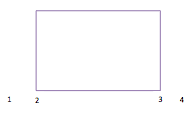 |
This
diagram represents becoming 1) married, 2) military, 3) retired, 4)
divorced. In other words, the entire military career was shared with
the same spouse. No coverture
fraction is required. Non-military spouse receives
nominally half of the disposable monthly retirement payment.
|
C = 1.0
|
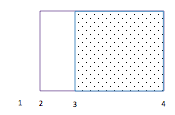 |
This
diagram represents becoming 1) married, 2) military, duty with or
without promotions, 3) divorced, duty without promotions, 4) retired.
Because there are no promotions after the marriage, this can be handled
like civilian retirements with a single coverture fraction.
|
C = DD/DR
|

|
This diagram represents becoming
1) military, 2) married, duty and promotions, 3) retired, 4) divorced.
|
C = (DRVR-DMVM)/(DRVR)
|
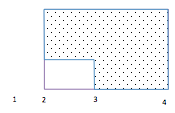
|
This diagram represents becoming
1) married, 2) military, duty with or without promotions, 3) divorced,
duty with promotions, 4) retired. In this situation, the Dual
Coverture Value method simplies to the Dual Coverture method.
This will give the same result as the DFAS Hypothetical method if you
stipulate that military pay raises are the same as COLA.
|
C = (DDVD)/(DRVR)
|
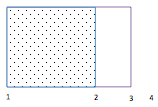
|
This
diagram represents becoming 1) military, duty with or without
promotions, 2) married, duty without promotions, 3) divorced, no more
duty or promotions, 4)
retired.
|
C = (DD-DM)/DR |
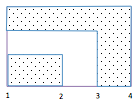
|
This diagram represents becoming
1) military, duty with or without promotions, 2) married, duty and
promotions, 3)
divorced, duty and promotions, 4) retired.
|
C = (DDVD-DMVM)/(DRVR) |
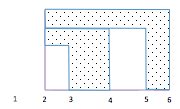
|
This diagram represents becoming
1) married #1, 2) military, duty with or without promotions, 3)
divorced, duty and
promotions, married #2, 4) married, duty without promotions,
5)divorced, 6) retired.
|
C1 = (DD1VD1)/(DRVR)
C2 = (DD2VD2-DM2VM2)/(DRVR) |
* The symbols and subscripts in the third column are defined earlier on
this web page. For this chart, the formula is simplified by cancelling
common factors in the numerator and denominator.
Comparison to DFAS Examples
In the Fall 2012 newsletter of the ABA
Family Law Military Committee,
Amy Privette, a previous paralegal for Mark Sullivan, wrote an article
titled "Quick Tips for Handling Military Retirement Benefits". She
echoed her mentor's errors by
identifying four DFAS methods of dividing military pay: fixed dollar,
percentage, formula, and hypothetical award. These correspond to
Sections IV(A), IV(C), and IV(D) of the DFAS 2012 document titled
"Guidance on
Dividing Military Retired Pay."
Privette stated that award formulas had to be stated one of these
four ways to be acceptable to DFAS. This is incorrect. In fact,
there are only two (2)
acceptable types for DFAS, while DFAS gave four (4)
examples. Confusion like this pervades the area of
military retirements asset division. Quoting paragraph
IV(A) from the
DFAS document, "The USFSPA states
that for a retired pay as property
award to be enforceable, it must be expressed either as a fixed dollar
amount or as a percentage of disposable retired pay."
Notice this quote identifies 2 options (fixed or percentage), not
4.
It is critical to realize that the DFAS "formula" or "hypothetical
methods"
calculate a percentage and therefore fit into the second type.
See the green hierarchy diagram above. More
revealing is the fact that ANY method that creates a fraction
percentage is acceptable to DFAS, so long as the fraction is directly
stated, or is possible for DFAS
to calculate. In DFAS'
words, "If a court order provides a
formula award and also provides all
the variables necessary to compute the formula, we will complete the
calculation as is [sic] using those variables provided in the
order."
If the fraction or percentage from two different methods
is the same, then any two methods are the same. This appears in
the hierarchy diagram above with the red equal sign. How you got to
the fraction just doesn't matter to DFAS.
All Dual Coverture methods create fractions and can be calculated by
DFAS. It is instructional to take each of the DFAS examples of
creating fractions and correlate them to the Area Method of creating
the same fraction.
Method
in DFAS published guidance
|
Simpler
DCV Formula giving the same fraction.
|
Fixed Dollar
|
percentage calculation not
required
|
Named Percentage
|
percentage calculation not
required (just state it).
|
Formula Example 2
|
C = DD/DR |
Formula Example 3
|
C = DD/DR |
Hypothetical Example 4 & 7
|
C = (DDVD)/(DRVR) |
Hypothetical Example 5 & 8
|
C = (DDVD)/(DRVR) |
Hypothetical Example 6 & 9
|
C = (DDVD)/(DRVR) |
Consider More than Monthly Amount
Selecting the proper method from the table above will correctly divide
the monthly retirement paycheck for Active Duty military and Reserve
military. For
Reserve
military, there is also a question of which paychecks are to be
divided. The value of the retirement asset includes attention to
dividing which checks in
addition to
dividing each check.
Traditionally, Reserve military retirement checks start when the
military member turns
60 years
of age because that's when a Reserve retirement begins to pay
out. However, 10 USC 12731(f)(2)(A) created a new and
quantifiably separate retirement for Reservists that does not comingle
in any way with the traditional retirement, and is created and is
accrued only based on military duty after January 28, 2008. If
the ex-spouse did
not participate in earning the new benefit after that date, then
retirement payments before age 60 are by definition not marriage assets
and therefore not divided. For more detailed
reading, see the Reservist
retirement division web page
or the bottom of the Area
Method web page.
Besides dividing each monthly payment, some or all of the
monthly retirement payments before military member age 60 may not be marital assets. See details
in the document "Attorney Instructions - Division
of Reserve and Active Duty Military
Retirements" from the references below, and
the web page
"Attorney Guide Dividing Military Reserve Pay".
Three conditions could exist.
- If a marriage
exists only after January 28th, 2008, then the retirement asset
is to be
divided the same way as described above.
- If a marriage ends
before
January 28th, the ex-spouse in no way contributes to the
retirement points accumulated after January 28th, which month-for-month
dictate how many months prior to age 60 retirement pay is started.
Getting these extra months of pay
is based only on duty after January 28th. Under this second condition,
the payments before age 60 would have a coverture fraction of zero --
in
otherwords, the non-military spouse would receive no portion of the
payments before age 60 because the spouse in no way contributed to the
duty points causing the payments. In this situation, the asset division
order must explicitly tell DFAS to not divide payments before age 60,
and divide payments like normal after age 60.
- If the marriage spans January
28th, then the payments age 60 and
following should be divided with a coverture fraction as described in
all the paragraphs above. For payments before age 60, a new area
value diagram must be created using only points after January
28th. The horizontal axes of the second
diagram would include points ONLY earned after January 28th. The
vertical axes would start with point value as of January 28th and show
only promotions after that date. This second area value diagram
would yield a second coverture fraction to apply for all payments
before age 60. DFAS must be provided with both coverture
fractions and directed to use one before age 60 and the other for age
60 and following.
Damages
The resultant damages of doing military division with a
single
(civilian) coverture when it should be a Dual Coverture or Area Method
are significant. If someone divorced as a Major and retired as a
Colonel, the 2013 pay chart shows a 34.4% increase in retirement
(proportional to base pay) due only to the rank change attained after
marriage. Other situations would be higher or lower. Because the
34% mistake would comes from
the military member to
the
non-military member, that creates a double,
or 68% average, error in equity. This is much larger than other
differences judged to be significant by courts, including the 15%
rule
of thumb on income changes to change support payments, or the 5%
threshold where medical insurance would be ordered for a supported
child. Over a 20 year retirement, this would accumulate a
$878,481
mistake in marital asset value. Multiply this error by the number
of military in the
nation and the
number
of divorces, and you'll
see that this is a $Billion dollar issue that needs the lucid,
equitable clarity of the Dual Coverture Value method.
Conclusion
Original research
has revealed the Area Method accomplishes the
same
division as previous standard methods, yet is much simpler. AM
also applies to a much wider scope of life situations which were
previously impossible. If you want to try numbers specific to
your situation,
download the Area method calculator
spreadsheet from the references
section below.
A practicum and
example are also available.
- Mork white paper: Attorney
Instructions - Division of Reserve
and Active Duty Military Retirements (increa
copy).
- DFAS "Guidance on Dividing Military Retired
Pay", March 2014, 25 pdf pages
with bad formatting, 121 KB pdf. (DFAS.mil,
increa
copy).
- Older copy April 2012, 20 pgs, 119
KB pdf. (DFAS.mil,
increa
copy).
- Older copy "Attorney
Instructions - Dividing
Military Retired Pay", April 2001,
19 pgs, 74kb pdf. (DFAS.mil,
increa
copy).
- DoD Report to Committee on Armed Services of the US Senate and
House of Representatives, 1998, 84 pgs, 279 KB pdf. (Defense.gov,
increa
copy)
- Blog post Dual
Coverture is better than DFAS Hypothetical Method,
February 2011.
- DCV Does Simple Division Orders--reply
to William Troyan.
- (out of date - see below for update)
PRE-NDAA2017 Excel spreadsheet for doing Dual
Coverture Value (Area Method) Calculations, September
2012. Includes court order legal language.
- (out of date - see below for update)
NPOST-NDAA2017 Excel spreadsheet for doing Dual
Coverture Value (Area Method) Calculator, March 2017. Includes
court order legal language.
- UPDATE: Excel spreadsheet for
doing both PRE- and POST-NDAA2017
calculations.
- "Female GIs struggle with higher rate of divorce", March 2011. (militarytimes.com,
increa copy)
- "Air Force divorce rate highest in military", December 2011. (militarytimes.com,
increa copy).
- "Be Specific in Divorce Agreements to Avoid Future Legal
Trouble", March 2011, (airforcetimes.com,
increa copy).

This document was
edited using Kompozer. © 2017
Brian Mork, Ph.D.



